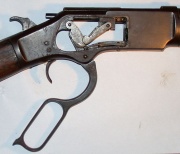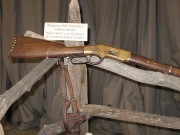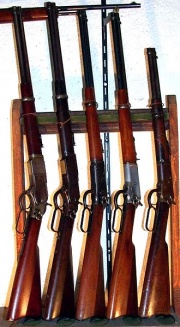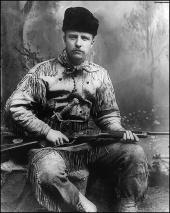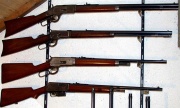Winchester rifle
| |||||||||||||||||||||||||||||||||||||||||||||||||
The term Winchester Rifle is frequently used to describe any of the lever-action rifles manufactured in the United States by the Winchester Repeating Arms Company, although the name is usually more specifically used in reference to the Winchester Model 1873 or the Winchester Model 1894 rifles.
Winchester rifles were among the earliest repeating rifles, and as such the Winchester name has become synonymous with lever-action firearms. The gun is colloquially known as "The Gun that Won the West", though public perception of its role in the Western Expansion is exaggerated due to the Winchester's prominence in 20th Century fictionalized accounts of that period.
Contents |
[edit] Predecessors
In 1848 inventor Walter Hunt of New York patented his "Volition Repeating Rifle" incorporating a tubular magazine, which was operated by two levers and complex linkages. The Hunt rifle fired what he called the "Rocket Ball," an early form of caseless ammunition in which the powder charge was contained in the bullet's hollow base. Hunt's design was fragile and unworkable; but in 1849 Lewis Jennings purchased the Hunt patents and developed a functioning, if still complex, version which was produced in small numbers by Robbins & Lawrence of Windsor, Vermont until 1852.[1]
Horace Smith and Daniel Wesson of Norwich, Connecticut acquired the Jennings patent from Robbins & Lawrence, as well as shop foreman Benjamin Tyler Henry. Smith made several improvements to the Jennings design, and in 1855 Smith and Wesson together with several investors formed a corporation, the Volcanic Repeating Arms Company, to manufacture Smith's modification of the Hunt-Jennings, the Volcanic lever-action pistol and rifle. Its largest stockholder was Oliver Winchester. [1]
For the Volcanic rifle Smith added a primer charge to Hunt's "Rocket Ball" and thus created one of the first fixed metallic cartridges which incorporated bullet, primer and powder in one self-contained unit. While still with the company Smith went a step further and added a cylindrical copper case to hold the bullet and powder with the primer in the case rim, thus creating one of the most significant inventions in firearms history, the metallic rimfire cartridge.[2] (Smith's cartridge, the .22 Short, would be introduced commercially in 1857 with the landmark Smith & Wesson Model 1 revolver and is still manufactured today.)
The Volcanic rifle had only limited success, which was in part attributable to the design and poor performance of the Hunt-derived Volcanic cartridge: a hollow conical ball filled with black powder and sealed by a cork primer. Although the Volcanic's repeater design far outpaced the rival technology, the unsatisfactory power and reliability of the .25 and .32 caliber "Rocket Balls" were little match for the competitors' larger calibers. Wesson had left Volcanic soon after it was formed and Smith followed eight months later, to create the Smith & Wesson Revolver Company. Volcanic moved to New Haven in 1856, but by the end of that year became insolvent. Oliver Winchester purchased the bankrupt firm's assets from the remaining stockholders, and reorganized it as the New Haven Arms Company in April 1857. [1]
Benjamin Henry continued to work with Smith's cartridge concept, and perfected the much larger, more powerful .44 Henry rimfire. Henry also supervised the redesign of the rifle to use the new ammunition, retaining only the general form of the breech mechanism and the tubular magazine. This became the Henry rifle of 1860, which was manufactured by the New Haven Arms Company, and used in considerable numbers by certain Union army units in the American Civil War. Confederates called the Henry "that damned Yankee rifle that they load on Sunday and shoot all week!"
[edit] Development
After the war, Oliver Winchester renamed New Haven Arms the Winchester Repeating Arms Company. The company modified and improved the basic design of the Henry rifle, creating the first Winchester rifle: the Model 1866. It retained the .44 Henry rimfire cartridge, was likewise built on a bronze-alloy frame, and had an improved magazine and a wooden forearm. In 1873 Winchester introduced the steel-framed Model 1873 chambering the more potent .44-40 centerfire cartridge. In 1876, in a bid to compete with the powerful single-shot rifles of the time, Winchester brought out the Model 1876 (Centennial Model). While it chambered more powerful cartridges than the 1866 and 1873 models, the toggle link action was not strong enough for the popular high-powered rounds used in Sharps or Remington single-shot rifles.From 1883, John Moses Browning worked in partnership with Winchester, designing a series of rifles and shotguns, most notably the lever-action Winchester Model 1886, Winchester Model 1892, Winchester Model 1894, and Winchester Model 1895 rifles, along with the lever-action Winchester Model 1887 shotgun and the pump-action Winchester Model 1893 and Winchester Model 1897 shotguns.
[edit] Winchester Lever-Action Repeating Rifles
[edit] Winchester Model 1866
The original Winchester rifle- the Winchester Model 1866- was famous for its rugged construction and lever-action mechanism that allowed the rifleman to fire a number of shots before having to reload: hence the term, "repeating rifle." Nelson King's new improved patent remedied flaws in the Henry rifle by incorporating a loading gate on the side of the frame and integrating a round sealed magazine which was covered by a fore stock. Originally chambered in the rimfire .44 Henry, the Model 1866 was nicknamed the "Yellow Boy" because of its "brass" receiver (actually a bronze alloy called gunmetal).
[edit] Winchester Model 1873
One of the most successful, and certainly one of the most famous Winchester rifles was the Winchester Model 1873, originally chambered for the .44-40 cartridge, although it was later produced in .38-40 and .32-20, all of which also became popular handgun cartridges of the day. Having a common centerfire cartridge in both revolvers and rifles allowed the owner to carry two firearms, but only one type of ammunition. Interestingly, the original Model 1873 was never offered in the military standard .45 Colt cartridge; although a number of modern reproductions of the rifle are chambered for the round. There was a limited number (approximately 19,000) of 1873 Winchesters manufactured in .22 rimfire caliber, which lacked the loading gate on the right side of the receiver. The Winchester Model 1873 was produced in such quantities that they became a common sight in the American West, leading to the rifle being nicknamed "The Gun that Won the West" on account of its prevalence and versatility. It inspired the 1950 Western film Winchester '73 starring Jimmy Stewart and directed by Anthony Mann.
[edit] Winchester Model 1876
The Winchester Model 1876 or Centennial Model was a heavier-framed rifle than the Model 1866 or Model 1873, and was the first to be chambered for full-powered centerfire rifle cartridges, as opposed to rimfire cartridges or handgun-sized centerfire rounds. It was introduced to celebrate the American Centennial, and earned a reputation as a durable and powerful hunting rifle. Originally chambered for the new .45-75 WCF cartridge (designed to replicate the .45-70 Gov't ballistics in a shorter case), versions in .40-60, .45-60 and .50-95 Express followed; the '76 in the latter chambering is the only repeater known to have been used in any numbers by the professional buffalo hunters.[3] The Canadian Mounties used the '76 in .45-75 as a standard long arm for many years with 750 rifles purchased for the force in 1883;[4] the NWMP-model '76 carbine was also issued to the Texas Rangers. Theodore Roosevelt used an engraved, pistol-gripped half-magazine '76 during his early hunting expeditions in the West and praised it.
[edit] Winchester Model 1886
The Model 1886 continued the trend towards chambering heavier rounds, and had an all-new and considerably stronger action than the toggle-link Model 1876. It was designed by John Moses Browning, who had a long and profitable relationship with Winchester from the 1880s to the early 1900s. In many respects the Model 1886 was a true American express rifle, as it could be chambered in the more powerful black powder cartridges of the day, such as the .45-70 Government (chambering a rifle for the popular .45-70 had been a goal of Winchester for some time). The 1886 proved capable of handling not merely the .45 Gov't but also the huge .45-90 and .50-110 Express "buffalo" cartridges,[5] [6] and in 1903 was chambered for the smokeless high-velocity .33 WCF. In 1935 Winchester introduced a slightly modified M1886 as the Model 71, chambered for the very powerful .348 Winchester cartridge.
[edit] Winchester Model 1892
- Main article: Winchester Model 1892
Winchester returned to its roots with the Model 1892, which, like the first lever-action guns, was primarily chambered for shorter, lower-pressure handgun rounds. The Model 1892, however, incorporates a much stronger Browning action (based on the larger M1886) than the earlier Henry-derived arms of the 1860s and 1870s. 1,004,675 Model 1892 rifles were made by Winchester, and although the company phased them out in the 1930s, they are still being made under the Puma label by the Brazilian arms maker, Rossi, and by Chiappa Firearms, an Italian factory. In its modern form, using updated materials and production techniques, the Model 1892's action is strong enough to chamber high pressure handgun rounds, such as .357 Magnum, .44 Magnum, and the high-powered .454 Casull round.
The 1892 was designed as a replacement for the 1873. While earlier rifles and shotguns actually "won the West," the majority of lever action rifles seen in classic Hollywood Westerns are Winchester '92 carbines chambered in .44-40 and .38-40 (to utilize the "5-in-1" blank cartridge). John Wayne famously carried these rifles in dozens of films set between the 1830s and the 1880s.
[edit] Winchester Model 1894
- Main article: Winchester Model 1894
Browning's Winchester Model 1894 is perhaps the best known of the Winchester repeating rifles, chambered for the newly introduced smokeless .30-30 Winchester cartridge, and later, a variety of calibres such as .25-35 WCF, .32-40 WCF, .32 Winchester Special, and the .38-55. Winchester was the first company to manufacture a civilian rifle chambered for the new smokeless propellants, and although delays prevented the .30-30 cartridge from appearing on the shelves until 1895, it remained the first commercially available smokeless powder round for the North American consumer market. Though initially it was too expensive for most shooters, the Model 1894 went on to become one of the best-selling hunting rifles of all time—it has the distinction of being the first sporting/hunting rifle to sell over one million units, ultimately selling over seven million—and US production was not discontinued until 2006. The Winchester 94/.30-30 combination was for many years practically synonymous with "deer rifle."
[edit] Winchester Model 1895
- Main article: Winchester Model 1895
The Winchester Model 1895 has the distinction of being the first Winchester lever-action rifle to load from a box magazine instead of a tube under the barrel. This allowed the Model 1895 to be chambered for military cartridges with spitzer (pointed) projectiles, and the rifle was used by the armed forces of a number of nations including the US, Great Britain, and Imperial Russia. Calibers included .30-40 Krag (.30 US or .30 Army), .303 British, .30-03 Springfield, .30-06 Springfield, 7.62mm Russian, and the mighty .405 Winchester. Teddy Roosevelt used a Model 1895 in .405 on African safari, and called it his "Big Medicine" for lions.[7] The Russian production models could also be loaded using charger clips, a feature not found on any other lever-action rifle.
[edit] Winchester Model 88
Introduced in 1955, sixty years after Winchester's last all-new lever-action design, the Model 88 was unlike any previous lever action; it was really a lever-bolt hybrid. A short-throw underlever operated a three-lug rotating bolt, and rounds were fed vertically from a detachable box magazine. These bolt-action features in a "lever-action" permitted the use of high-powered modern short-case cartridges with spitzer bullets: .243, .284, .308 (7.62mm NATO) and .358 Winchester. The 88 did not prove to be especially popular, although it has its share of devoted enthusiasts, and was discontinued in 1973. The later Sako Finnwolf and Browning BLR have similar actions. A Winchester Model 88 in .308 Caliber was used to harvest the current World's Record Typical Whitetail Deer.
[edit] Winchester Model 9422
Winchester's Model 9422 was introduced in 1972 and was rapidly recognized for high quality. It was designed to capture the image of the traditional lever-actions with exposed hammer, straight grip, tube magazine and barrel bands. Unlike older Winchester lever actions it came grooved for scope mounting. It was offered in .22 Long Rifle and .22 WRM, and was priced at the high-quality end of the .22 sporting rifle market.
The 9422 action design was original and extremely reliable. The feed system handled the cartridge from the magazine to the breech face by its rim, and the slide cammed the rear of the breechblock up into the locking recess. A concealed polymer buffer above the breech gave a firm-feeling lockup and a very positive unlocking motion.
The 9422 had worldwide appeal to customers raised on 'westerns' and to those looking for a fun and historic way to introduce their children to shooting. Over the course of production a higher finished model called the 9422 XTR, a .17 rimfire model, and several commemorative models were offered. Production ended in 2005.[8]
[edit] Winchester Model 1885 Single Shot Rifle
- Main article: Winchester Model 1885 Single Shot Rifle
In 1885 Winchester entered the single-shot market with the Model 1885 rifle, which John Browning had designed in 1878 (the beginning of the fruitful 20-year Winchester-Browning collaboration). The Winchester Single Shot, known to most shooters as either the "Low-wall" or "High-wall" depending on model, but officially marketed by Winchester as the Single Shot Rifle, was produced to satisfy the demands of the growing sport of "Match Shooting", excelling at it, with Major Ned H. Roberts (inventor of the .257 Roberts cartridge) describing the Model 1885 Single Shot as "...the most reliable, strongest, and altogether best single shot rifle ever produced."[9] Winchester produced nearly 140,000 Single Shot rifles from 1885 to 1920, and it was found that the falling-block Model 1885 had been built with one of the strongest actions known at that time. Winchester also produced a large number of Single Shots in .22 Short for the US Army as a marksmanship training rifle, the "Winder musket."
[edit] Winchester Bolt Action Rifles
Winchester lever action rifles remained the most popular in the US through WWI and the interwar period. However, advances in the development of bolt action rifles made them increasingly preferred over lever actions. These new rifles, such as the Mauser Gewehr 98 and M1903 Springfield, could chamber pointed "Spitzer" bullets, which lever action rifles with tube magazines could not (a pointed bullet can accidentally fire the round in front of it in a tube magazine). Bolt actions as developed by Mauser and other military manufacturers had front locking lugs which stabilized the cartridge head very well, and allowed for unprecedented accuracy. Bolt actions were simpler and cheaper to manufacture than high-power leverguns like Winchester's 1886 and 1895 models.
In response to the increasing competition from these bolt-action rifles, Winchester introduced the Winchester Model 54 in 1925. This was not Winchester's first bolt rifle (that distinction belonged to the Winchester-Hotchkiss rifle of 1878), but it was by far their most successful. It was based on the Mauser Gewehr 98 design, but with modifications and popular North American chamberings such as .30-06 which made it more appealing to American hunters than were the European imports or sporterised military rifles. The famed Model 70 was developed from the Model 54, which it replaced in 1936. The Model 70, often dubbed the "rifleman's rifle,"[10] was produced continuously at New Haven (except during WWII) until 2006, and production has resumed at FN Herstal's plant in Columbia, South Carolina.
From 1900 Winchester manufactured cheap single shot .22 bolt action rifles, including the models 1900, 1902, 1904 and 99. On the other hand, in 1920 Winchester introduced the high-quality Model 52 .22 bolt action target rifle, which from its inception and for years thereafter was America's reference standard smallbore match rifle. A very desirable sporter model of this action was also made from 1934-59. [11]
[edit] Winchester Self-Loading Rifles
[edit] Winchester Models 1903 and 63
The Winchester Model 1903 was the first commercially available self-loading .22 rimfire caliber in the US. Designed by T.C. Johnson, the Model 1903 was chambered for the unique .22 Winchester Automatic cartridge. In 1919, the Model 1903 moniker was shortened to Model 03, and following a partial redesign in the 1930s, was renamed the Model 63. The Model 63, introduced in 1933, was chambered for the popular and widely available .22 Long Rifle cartridge. It was initially made with a 20" barrel, then with a 23" barrel from 1936 until the end of production in 1958. About 175,000 Model 63 rifles were manufactured, with the last 10,000 having grooved receiver tops for scope mounting. Both the 1903/03 and the 63 have tubular magazines in the butt stock of the rifle and are loaded through a slot in the right side of the butt stock.
[edit] Winchester Models 1905, 1907, and 1910
- Main article: Winchester Model 1905, Winchester Model 1907, and Winchester Model 1910
The early centerfire Winchester self-loading series of rifles began with the Model 1905, chambered for the .32SL and .35SL cartridges. Following a demand for a higher-powered self-loading rifle, the Models 1907 and 1910 were introduced along with their respective cartridges, the .351SL and .401SL.[12]
[edit] Winchester repeating shotguns
[edit] Winchester Model 1887/1901
- Main article: Winchester Model 1887/1901
The Winchester Model 1887 was the first successful repeating shotgun design, developed by John Browning and produced by Winchester from 1887-1920. Browning felt that a pump-action would be much more appropriate for a repeating shotgun, but as Winchester was primarily a lever-action firearms company they felt that their new shotgun must also be a lever-action for reasons of brand recognition. The M1887 was chambered for 12ga black powder shotshells, and after the switch to smokeless powder at the end of the 19th Century, the M1901 was introduced, being chambered for 10ga smokeless shells. Although a technically sound gun design, the market for lever-action shotguns waned considerably after the introduction of the Winchester 1897 and other contemporary pump-action shotguns; modern reproductions of the gun have been manufactured by Norinco in China, ADI Ltd. in Australia and Chiappa Firearms in Italy.
[edit] Winchester Model 1893/1897
- Main article: Winchester Model 1897
Another Browning design, the Winchester Model 1893 (and later Model 1897) was one of the first successful pump-action shotgun designs, being introduced in 1893 and remaining in production until the mid 1950s. Unusual for a repeating shotgun, the Model 1897 could be taken apart for easier carriage/storage, and was available in a variety of barrel lengths from 20in to 36in. During World War I it was issued as a trench gun, with short barrel, heat shield and M1917 bayonet.
[edit] Winchester Model 1911
- Main article: Winchester Model 1911
Winchester's long association with John Browning came to an end acrimoniously when the company refused to accept Browning's terms for the right to manufacture his revolutionary 1898 design for a self-loading shotgun; the landmark Browning Auto-5 was produced instead by Fabrique Nationale in Europe and later by Remington Arms in the US. However, Browning's semi-automatic patents had been so tightly drafted by Winchester's own lawyers that it took years for T. C. Johnson to develop a self-loading shotgun which didn't infringe them; this was the Model 1911 SL. The 1911 unfortunately was a flawed and potentially dangerous design, and was not a commercial success; it was dropped in 1925.
[edit] Winchester Model 1912
- Main article: Winchester Model 12
Designed by T.C. Johnson as a hammerless modification of the Model 1897, the Model 1912 (later re dubbed the Model 12) was one of the most successful pump shotguns ever made, with nearly 2 million produced before its cancellation in 1963. Like the Model 1897 it came in take-down form, and likewise was issued in trench gun and combat versions during both World Wars, Korea and Vietnam. The Model 12 was popular with the military, law enforcement, hunters, and sporting clay competitors, the latter regarding it as having superior balance and "point" among pump-actions.
[edit] 1964 Changes
In the mid-to late 1950s, Winchester saw a management change which led to an extensive and extremely controversial [13] redesign of their firearms in 1964. This is regarded by many[14] as the year the "real" Winchester ceased to be, and consequently "pre-'64" rifles command higher prices than those made afterwards. Winchester itself went on to have a troubled future as competition from both the US and abroad began to decrease its sales. Although in the 1970s the company attempted to recover its reputation by bringing out the well-received SuperX-1 semiautomatic shotgun, produced along pre-1964 lines, the cost of manufacture again proved unsustainable. In 1980, the company was split into parts and sold off. The name "Winchester" remained with the ammunition making side of the company, and this branch continues to be profitable. The arms making side and New Haven facilities went to U.S. Repeating Arms, which struggled to keep the company going under a variety of owners and management teams. It finally announced plans to close the New Haven facility, the producers of the Model 1894, in 2006.
On August 15, 2006, Olin Corporation, owner of the Winchester trademarks, announced that it had entered into a new license agreement with Browning to make Winchester brand rifles and shotguns, though not at the closed Winchester plant in New Haven. Browning, based in Morgan, Utah, and the former licensee, U.S. Repeating Arms Company, are both subsidiaries of FN Herstal. In 2008 FN Herstal announced plans to produce Model 70 rifles at its plant in Columbia, SC.
[edit] See also
- Winchester Repeating Arms Company
- List of Winchester Models
- John Browning
- Benjamin Tyler Henry
- Henry rifle
- List of rifle cartridges
- Mare's Leg
- Single-shot
- Oliver Winchester
- Winchester Model 70
- Antique guns
[edit] References
- ↑ 1.0 1.1 1.2 Taylor, Jim, A Short History of the Levergun, http://www.leverguns.com/articles/taylor/history.htm
- ↑ Smith's cartridge was derived largely from the Flobert BB Cap, but the Flobert design contained no powder. The cylindrical case was in all likelihood inspired by another French design, the Lefaucheux pinfire cartridge.
- ↑ "The Winchester Model 1876 Rifle", Bar-w.com
- ↑ p. 542 Walter, John Rifles of the World 2006 Krause Publications
- ↑ As well as the related .50-100 and .50-105. Barnes, Frank C., ed. by John T. Amber. ".577/500 Magnum Nitro Express", in Cartridges of the World, p.116.
- ↑ "Winchester's Big 50", American Rifleman.
- ↑ Madis, p. 426
- ↑ Dave Anderson "Gone but not forgotten: Winchester's 9422 lever action". Guns Magazine. . FindArticles.com. 21 Jan. 2009. http://findarticles.com/p/articles/mi_m0BQY/is_9_51/ai_n14816188
- ↑ Kelver, p. 47
- ↑ "Winchester Model 70 rifles (Win. Model 70)" Chuckhawks.com
- ↑ Houze, Herbert (2006). The Winchester Model 52: Perfection in Design. Gun Digest Books. p. 72. ISBN 0896891631, 9780896891630.
- ↑ Stebbins, Henry. Rifles: A Modern Encyclopedia. Stackpole Co. 1958.
- ↑ Shooting writer Jack O'Connor: "...I saw the pilot model of 'New Model 70.' At the first glimpse I like to fell into a swoon. The action was simplified, the trigger guard and floor plate made of a flimsy looking one-piece stamping. The stock had stodgy lines and no checkering, and the barrel channel was routed out so much a herd of cockroaches could hold a ball below the barrel... I told them the creation would not sell, that it was one of the ugliest rifles I had ever seen.""
- ↑ "1964 was a big year for Olin/Winchester. That was the year that their revised (for cheaper manufacture) line of firearms was introduced. The reaction from gun writers and the shooting public to the changes was swift and terrible, and Winchester has never regained their former position of dominance." Hawks, Chuck, "The Winchester Model 94",
[edit] Sources
- Out With A Bang: The Loss of the Classic Winchester Is Loaded With Symbolism, Washington Post, January 21, 2006
- Know the enemy: Have gun will vote.com, May 19, 2003
- End of an era as Winchester rifle plant prepares to close, Pittsburgh Tibune-Review, January 18, 2006
- End of an era as Winchester rifle plant prepares to close, NC Times.com January 17, 2006
- Kelver, Gerald O. Major Ned H. Roberts and the Schuetzen Rifle. 1998. Pioneer Press
- Campbell, John. The Winchester Single Shot. 1998. ISBN 0-91721-868X
- Madis, George, The Winchester Book, Houston: Art and Reference House 1971



